If you have knee pain with sports or dance, most people tend to focus blame only at the knee.
However, failing to blame your butt may be failure to fully help heal your knee pain.
While some may chuckle at the mention of butt, poor buttock and hip muscle function is no laughing matter.
Knee Pain- How Does your Butt Play a Role?
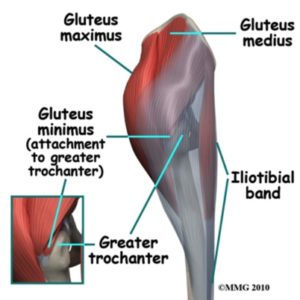
Gluteal muscles and iliotibial band- image courtesy of https://eorthopod.com/hip-arthroscopy/
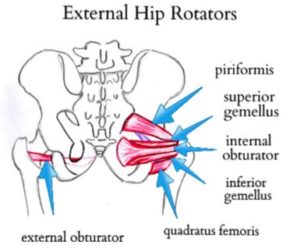
Hip external rotator muscles- image courtesy of https://lowbackpainprogram.com/hip-rotators-and-pain/
When running, jumping, squatting, turning or landing, the best knee position is right under the hip and above the 2nd toe.
Muscles in the buttock and back of the hip are key for controlling this leg alignment.
Certain muscles such as gluteals (medius and maximus) and hip lateral (external) rotators are the knee’s best friend.
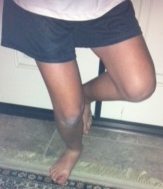
Dramatic example of abnormal right knee valgus with internal movement of thigh and knee
The gluteal muscles are known as hip “abductors” that help keep the pelvic stable.
Gluteal muscle function keeps the knee and lower leg from collapsing inward (aka knee valgus).
Appropriate function of the hip lateral rotators keeps the thigh from rotating inward.
Inward thigh rotation and knee collapse can cause increased stress between the knee cap and thigh bone.
This abnormal kneecap position can not only cause immediate pain, but also increase risk of more significant knee injuries.
CLICK FOR RELATED CONTENT: Knee ACL Injury: How a few minutes a week can prevent years of tears
Checking the Butt Muscles
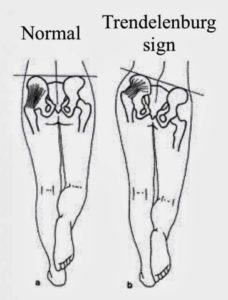
Trendelenberg sign on right side of pelvis due to weak gluteal/abductor muscles- image courtesy of http://epomedicine.com/clinical-medicine/trendelenburg-test-or-sign/
There are a few relatively quick tests of the gluteal and hip external rotator muscles.
One is the Trendelenberg Test where I’ll ask the patient to stand one one food and raise up the other knee.
If the gluteus medius is working, the pelvis should not drop on the raised knee side.
Next, I’ll ask patients to do single leg squats or step-ups.
I’ll keep an eye on if the kneecap stays under the hips and above the 2nd toe.
On this video, notice that the kneecap stays right under the hip and above the second toe. This means the hip and gluteal muscles are doing their job well.
This second video shows more “wiggling” of the left knee as it collapses inward toward the right knee. Notice how the patient says “this is hard” and has to move her left ankle for better control.
If there are problems in my exam room, I can only imaging what happens during sports or dance.
Speaking of dancers, I like to evaluate plie technique with turnout in 2nd position.
I’ll drop an imaginary line from the kneecap to the floor.
If that line falls on top or inside of the big-toe, then there is concern about those hip and buttock muscles.
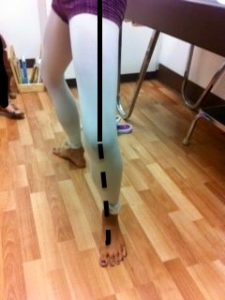
Plie in Second Position- solid line shows hip above kneecap, broken line shows kneecap above second toe
Dancers can use mirrors and the barre to focus on this proper knee alignment- especially with the basic five ballet positions.
Knee Pain- Does a Weak Butt also affect the IT Band?
First of all, what exactly is the IT Band?

Image courtesy of https://www.medicinenet.com/iliotibial_band_syndrome/article.htm
The iliotibial (IT) band is soft tissue band on the outside of the thigh that runs from the pelvis to the knee.
Tight IT bands can cause pain on the outside of the hip and knee while also putting abnormal pressure on the kneecap.
Many patients will report tightness of the IT Band and hope that stretches will lead to less pain and stiffness.
Often, a tight IT band is due to overload from weak gluteal muscles (especially that gluteus medius).
So while stretches may help reduce IT band tightness, a stronger gluteus medius will do more to reduce IT band pain.
Knee Pain- How to Help the Butt and Hips
Ready to make your butt and hips work better to help your knee pain?
I’ll share one of my favorite set of exercises for gluteal and hip external rotator strength.
All you’ll need is a mat or soft surface and of course, your cell phone.
Check out this video for more information
Final Words
You’ve started work on reducing knee pain by making your butt and hips work more effectively.
One video set of exercises is a good start, but there is definitely more that you should do.
Checking in with a sport or dance medicine specialist can help make sure nothing else is causing your knee pain.
Besides weak butts and hips, injuries to the knee itself or even limited big toe motion can be problems.
YES, BELIEVE IT OR NOT- THE BIG TOE CAN BE A BIG PROBLEM.
CLICK FOR RELATED CONTENT: Big Toe Limitations: Don’t Let This Little Joint Cause Big-Time Knee Issues
A comprehensive evaluation should give advice on proper techniques and additional exercises to build strength.
Don’t continue to have your butt let you down.
Your knees will be thankful to share the blame.


